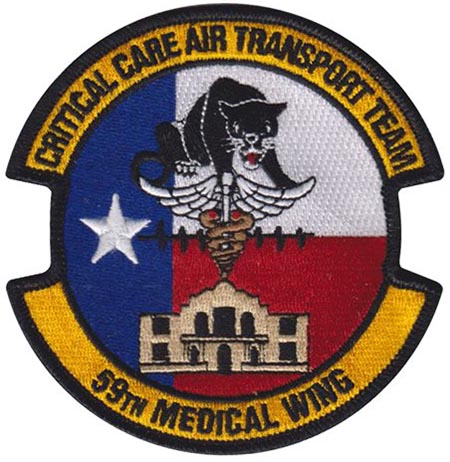Description
Computer made/mounted on velcro 4.0 inch-100mm
59th MEDICAL WING
Lineage. Established as 59 Observation Group on 21 Aug 1941. Activated on 1 Sep 1941. Inactivated on 18 Oct 1942. Activated on 1 Mar 1943. Redesignated as: 59 Reconnaissance Group on 2 Apr 1943; 59 Fighter Group on 11 Aug 1943. Disestablished on 1 May 1944. Redesignated as 59 Tactical Fighter Wing on 31 Jul 1985 but remained inactive. Consolidated (1 Jul 1993) with Wilford Hall USAF Medical Center, which was first designated as the 3700 Medical Squadron on 25 Aug 1948. Organized on 26 Aug 1948. Redesignated as: 3700 Station Medical Squadron on 1 Nov 1948; 3700 Medical Group on 27 Jun 1950; 3700 USAF Hospital on 16 Oct 1953; USAF Hospital, Lackland on 1 Jul 1958; Wilford Hall USAF Hospital on 2 Mar 1963; Wilford Hall USAF Medical Center on 1 Jul 1969; 59 Medical Wing on 1 Jul 1993.
Assignments. I Air Support (later, I Ground Air Support) Command, 1 Sep 1941; First Air Force, 21 Aug–18 Oct 1942. Third Air Force, 1 Mar 1943; III Fighter Command, by Sep 1943–1 May 1944. 3700 Basic Training Wing, 26 Aug 1948; Indoctrination Division, Air Training Command, 22 Apr 1949; 3700 AF Indoctrination Wing (later, 3700 Military Training Wing; Lackland Military Training Center), 28 Oct 1948; USAF Aerospace Medical Center, 1 Oct 1959 (attached to Aerospace Medical Division, 1 Nov 1961–14 Apr 1962); Aerospace Medical Division, 15 Apr 1962; Air Training Command, 15 Jan 1987; San Antonio Joint Military Medical Command, 16 Feb 1987; Air Training (later, Air Education and Training) Command, 1 Oct 1991–.
Operational Components. Squadrons. 9 Observation (later, 9 Reconnaissance; 488 Fighter): 1 Mar 1943–1 May 1944. 103 Observation: 1 Sep 1941–18 Oct 1942. 104 Observation (later, 104 Reconnaissance; 489 Reconnaissance; 489 Fighter): 1 Sep 1941–18 Oct 1942; 1 Mar 1943–1 May 1944. 119 Observation (later, 119 Reconnaissance; 490 Fighter): 1 Mar 1943– 1 May 1944. 126 Observation (later, 126 Reconnaissance; 34 Photographic Reconnaissance): 1 Sep 1941–18 Oct 1942; 1 Mar 1943– 11 Aug 1943. 447 Fighter: 20 Nov 1943–1 May 1944.
Stations. Newark, NJ, 1 Sep 1941; Ft Dix, NJ, 14 Nov 1941–18 Oct 1942. Ft Myers, FL, 1 Mar 1943; Thomasville AAFld, GA, c. 30 Mar 1943–1 May 1944. Lackland AFB, TX, 26 Aug 1948–.
Aircraft. BC–1A, 1941–1942; L–59, 1941–1942; 0–46, 1941–1942; 0–47, 1941–1942; O–49, 1941–1942; 0–52, 1941–1942. P–39, 1943–1944; P–40, 1944.
Operations. Following the outbreak of war, engaged in antisubmarine patrol along the East coast of the United States, Dec 1941–Oct 1943. During 1943–1944, trained pilots using P–39 aircraft. During the Korean War, developed a program to train basic trainees as medical corpsmen to ease shortage of medical personnel. From 1983, offered centralized outpatient care, a clinical investigation facility, the Air Force’s largest dispensary system, and the only eye bank and organ transplant centers. Accomplished important research work in neonatal medicine, surgical transplants, orthopedic surgery, rheumatology, immunology, and maxillofacial surgery. Clinical investigations research kept the wing at the forefront of development of high-frequency ventilation and extra-corporeal membrane oxygenation; new techniques for the care of premature infants; improved cancer treatments; bone banking and transplantation; laser photocoagulation; and acquired immune deficiency syndrome (AIDS). In Dec 1989, provided medical support to casualties returning from operations in Panama. From 4 Jan to 21 Mar 1991, deployed over 900 personnel to RAF Little Rissington, England, to establish a 1500-bed hospital in support of expected casualties from the Southwest Asia War. Trained most of the Air Force’s physician and dental specialists at Wilford Hall Medical Training Center on Lackland AFB, TX, 1991-.
Service Streamers. None.
Campaign Streamers. World War II: Antisubmarine, American Theater.
Armed Forces Expeditionary Streamers. None.
Decorations. Air Force Outstanding Unit Awards: 1 Jul 1957–31 Dec 1963; 1 Jan 1965–30 Jun 1966; 1 Jan 1975-31 Dec 1976; 1 Jan 1979-31 Dec 1980; 1 Jan 1983-31 Dec 1984; 1 Jan 1986–31 Dec 1987; 19 Dec 1989–31 Jan 1990; 1 Jul 1994-30 Jun 1996; 1 Jul 1997-30 Jun 1998; 1 Jul 1998-30 Jun 1999; 1 Jan 2000-31 Dec 2001; 1 Jan 2002-31 Dec 2003; 1 Jan-31 Dec 2004; 1 Jan 2005-30 Jun 2006; 1 Jul 2006-30 Jun 2007; 1 Jul 2007-30 Jun 2008; 1 Jul 2008-30 Jun 2009; 1 Jul 2009-30 Jun 2010.
Emblem. Approved on 3 Feb 1995.
CRITICAL CARE AIR TRANSPORT TEAM (CCATT)
The Critical Care Air Transport Team (CCATT) is a unique, highly specialized medical asset that can create and operate a portable intensive care unit (ICU) on board any available transport aircraft during flight. It is a limited, rapidly deployable resource and a primary component of the Air Force’s Aeromedical Evacuation (AE) System. The CCATT team is a three-person medical team consisting of a physician specializing in an area such as critical care, pulmonology, surgery, etc., along with a critical care nurse and a respiratory technician. The team is experienced in the care of critically ill or injured patients with multi- system trauma, shock, burns, respiratory failure, multiple organ failure and other life threatening complications. The complex, critical nature of the patient’s condition requires continuous stabilization, advanced care, life-saving invasive interventions during transport, and life or death decisions.
